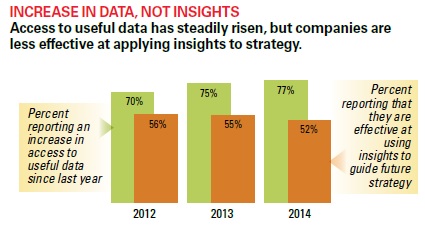Competing on Data Talent

In my last post, I introduced the longitudinal study that MIT Sloan Management Review has been conducting over the past five years. From 2010 to 2012 they indicated that 67% of those surveyed believed that analytics gave their organizations a competitive edge. In 2013, that figure stabilized at 66% revealing the so called ‘Moneyball Effect’ where leaders lost their competitive edge that they once enjoyed because followers matured and made analytics core competencies. In 2014, that trend continued, falling to 61%.
But why?
According to MIT’s most recent report The Talent Dividend, competing on getting the right data has become as important as competing with data. Although access to useful data has risen, organizations are realizing very quickly that they are not as effective at applying insights to strategy. This is where the gap lies; analytical talent is now driving competitive advantage at data-oriented companies.
The McKinsey Global Institute estimates that by 2018, the U.S. economy will have a shortage of 140000 to 190000 people with analytical expertise and a shortfall of another 1.5 million managers and analysts with the skills to understand and make decisions.
So what do you do?
Besides becoming intimately familiar with your data ecosystem, invest in developing or acquiring talent who can quickly understand your market forces and, in turn, who can fetch data, mash it together and identify opportunities and threats. The most successful data scientists come from completely unrelated fields. Developing talent internally is beneficial as it taps those who already know your business and can communicate insights to end users, a gap known as the ‘last mile’ problem in analytics. Integrating external talent using a buddy system gives them an opportunity to absorb your corporate culture and to better understand your business. Establishing a solid data governance strategy including a standard operating procedure on accessing and using data so that meetings focus on addressing the ‘why’ and the ‘how’ instead of expending valuable energy debating the validity and relevance of the data.
Who can help?
Building all this can be an arduous task. If you have challenges, partner with organizations who have the technical expertise and who understand you and your business. Your ideal partner must be able to work with you on defining your strategy, aligning your analytics activities with your strategic objectives and initiatives, and will walk alongside you providing ongoing support, mentorship, and guidance. This kind of relationship not only will raise your analytics maturity level, it will allow you to develop your internal analytics talent along the way.
Let your journey continue.


